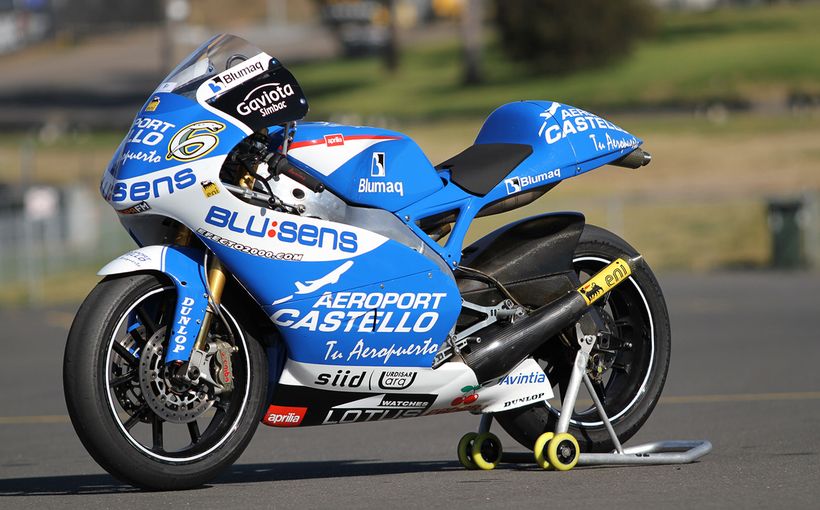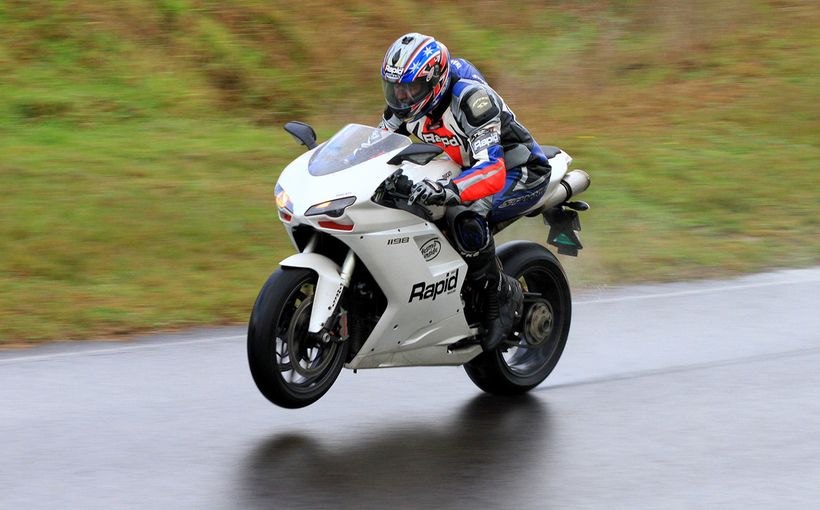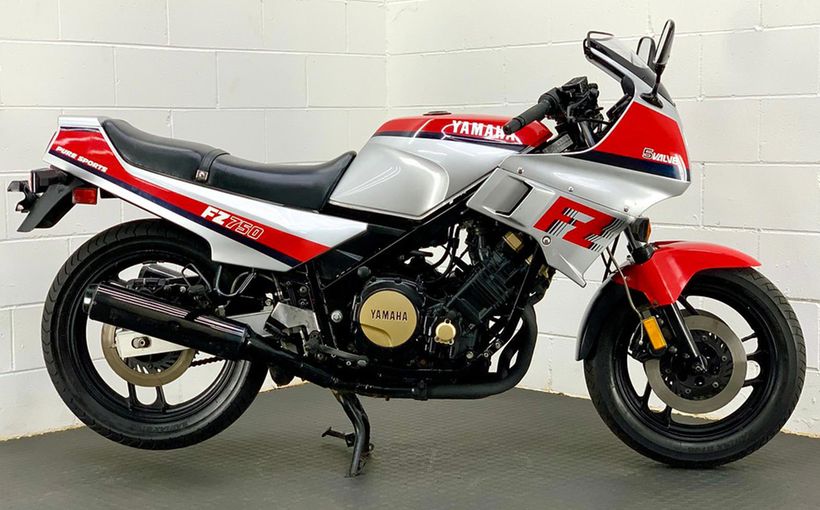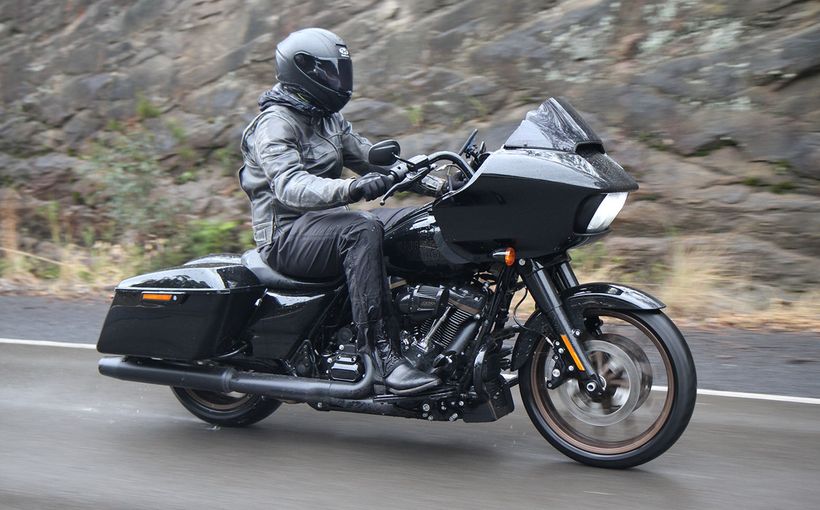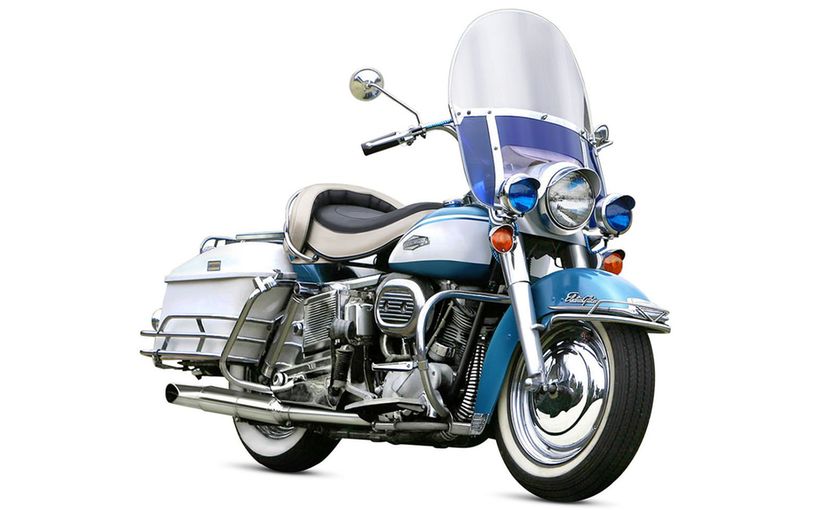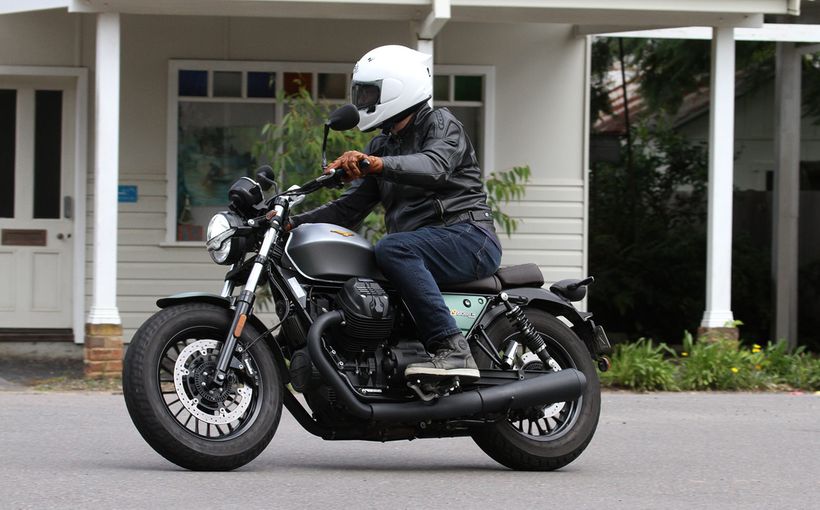2018 Harley-Davidson Softail Range: Tails from the hard side

If you’ve ever been attracted to a Harley-Davidson big-twin cruiser but were put off by their dynamic shortcomings, umm, it’s time to take another look.
It’s as if a fire has been lit under the iconic Milwaukee brand’s lazy, old arse because these all-new Softails, which mark the largest R&D project in Harley- Davidson’s development history, are far from being slow, fat and cumbersome. Quite the opposite, actually.
The eight cruisers also have more distinctive personalities to help set them apart from their siblings and their predecessors, punctuated by striking daytime-running LED headlights that are unique to each model. There’s also a higher attention to detail, which means exposed wiring and feeble sidestands be gone. And that’s just for starters.
Due in showrooms from October, the range comprises the Fat Boy, Heritage Classic, Softail Slim, Deluxe and the strong-selling Breakout as well as the Fat Bob, Street Bob and Low Rider, which used to be based on the outgoing Dyna platform. Rideaway prices range between $23,495 and $34,750 for the Low Rider and Heritage Classic 114 Anniversary respectively.
Even Harley admits it needed to offer more. “Historically, we’ve leaned on ‘look’, ‘sound’ and ‘feel’, but we recognise that we needed to raise the bar,” Harley-Davidson Softail styling manager Kirk Rasmussen says.
As such, the 2018 Softails mark a turning point for the 114-year-old motorcycle company because they’re deceivingly sharp and capable when the road turns twisty. How? Because over the old Softail and Dyna, they feature an all-new chassis that’s lighter and stiffer; they roll on more controlled and compliant suspension; they have more cornering clearance and, last but not least, they’re powered by a revised version of the outstanding Milwaukee- Eight 107 engine that debuted in the Touring range last year. In isolation, each of the above changes represents a huge leap for the company. As a package, they’ve created bikes unlike any that have rolled out of Milwaukee.
But there’s another important question regarding the seismic shift: Why now? As in, why not five, 10 or 20 years ago? The answer, with all due respect, could be because baby boomers, who currently represent the lion’s share of Harley’s customer base, are starting to hang their helmets.
The company knows it can’t wait up to 30 years for the next generation of devout Harley riders to progress from the Street and Sportster families – it needs to get them hooked on its Big Twin bikes now. For proof, look no further than the Fat Bob’s overt zombie apocalypse treatment to appeal to younger, style-conscious riders. And is it a coincidence that this 37-year-old rider was invited to attend the international launch?
FUTURE PROOFING
Harley-Davidson has announced a 10-year plan to engage the next generation of faithful riders. That includes attracting two million new riders to the brand in the US plus two million more globally. It also aims to grow international business to 50 per cent of annual production and launch “100 high-impact models”, some of which we’ve already seen.
Part of that strategy involved consolidating the Dyna and Softail cruiser platforms into one diverse line-up. And just like that, no more confusion in the showroom.
The company says the best-of-both-worlds approach meant combining the harder-riding nature of the Dynas, with their exposed shocks, and melding their much-loved characteristics with the cleaner-looking Softails, which are easily identified by their hidden shocks for an old-school rigid look. But the move to retire the Dyna hasn’t been an easy pill to swallow for the ‘Dyna guys’ we spoke to including renowned custom bike builder Roland Sands. Harley, however, is confident that once they ride the all-new bikes they won’t look back. With a lighter, stiffer chassis, a more powerful engine and sharper styling – and far more engaging and dynamic ride experience – we’ve no reason to suggest otherwise.
The retirement of the Dyna platform consolidates the Harley-Davidson family to six ranges: Street, Sportster, Softail, Touring, Trike and CVO. It also spells the end of the Dyna-based Wide Glide.
The 2018 Softail’s new carbon-steel tubular frame is said to be 65 per cent stiffer than the outgoing Softail design (and a whopping 91% stiffer than the Dyna), which leads to a 34 per cent increase in overall chassis stiffness. Its simplified design also allows a 50 per cent reduction in component parts and a 22 per cent reduction in welds. Mind you, such improvements surely couldn’t be too difficult to obtain compared with a 33-year-old frame.
Two swingarms are on offer to accommodate narrow and wide rear tyres and are said to be 8.16kg and 5.89kg lighter respectively. Overall, the Softails are up to 17kg, or around 20 per cent, lighter than before thanks also to the use of more aluminium. The Jenny Craig program obviously not only improves acceleration but also makes for better braking and handling. This is complemented by increased cornering clearance on several models, sharper turn-in response and easier sidestand lift. They’re still cruisers, however – not razor-sharp sportsbikes – but they’re a helluva lot better than before with enough engagement to impress the herd of Aussie scribes.
The new Softail is a better-looking frame, too, with a more triangulated, uninterrupted backbone from steering head to rear axle while the old Softail’s underslung twin shocks have been replaced with a single one under the seat. The preload-adjustable, coil-over shock preserves the classic hardtail look while the geometry, with three steering-head angles (28, 30 and 34 degrees) depending on the model, has been revamped to “improve ride quality, traction and control”.
Up front, the bikes receive Showa forks with ‘dual-bending valve’ technology from the 2017 Touring models, which is claimed to deliver damping performance similar to a cartridge fork but with better damping characteristics. One bike, the Fat Bob, is distinguished by an upside-down cartridge fork and the steepest steering head angle of the range, at 28 degrees.
The form and function changes also include an oil cooler that’s neatly integrated between the downtubes and engine oiling by a new wet sump system, which eliminates the traditional separate oil tank under the seat. That helps improve the bike’s centre of gravity while making room for the electrics and battery, which are accessed via the removable side panels.
MILWAUKEE SPRAWL
The Softail range is powered by the nowfamiliar air-/oil-cooled Milwaukee-Eight 107 V-twin (107ci/1750cc) that produces 145Nm at 3250rpm – 5Nm down compared with the tourers. The other change to the eight-valve unit is the addition of a second gear-driven balancer to reduce the rocking that can be transmitted to the rider in solidmounted engine applications.
Meanwhile, a new Milwaukee-Eight 114 (114ci/1868cc) unit is available on four models including Fat Bob 114, Fat Boy 114, Breakout 114 and Heritage Classic 114. It’s not to be confused with the 165Nm liquid cooled Milwaukee-Eight 114 unit found in the performance-oriented CVO Touring models. Instead, this 114 unit is air-/oil cooled and delivers 155Nm at 3000rpm, for around 13 per cent faster acceleration than the 107. Pricing for the larger Softail engine varies between $2245 and $3000 depending on the model.
The company’s ninth Big Twin is more adept in snail-pace traffic, with better heat management (as we found out in the traffic of 40-degree LA) and far less jerky thanks to crisp fuelling. The slip-assist clutch is the lightest it’s ever been, too, which is welcome in stop-start situations.
But it’s really in the acceleration where this air/oil-cooled 107ci (1750cc) engine shines. Similar to the Road King Special we tested in the last edition, the Milwaukee-Eight provides a real sense of urgency during quick overtaking manoeuvres at highway speeds or when gunning out of corners. And that’s now without needing to drop down a cog or two for convincing propulsion, unlike the old Twin Cam 103. If you do, it happily responds in the higher revs with a grunty snarl and impressive momentum. Alternatively, you can let it drop in engine speed then give it a handful at 2000rpm. The real-world performance difference between a heavier bike such as the Road King and any of the lighter Softails is considerable.
Yep, the broadness of the new engine’s torque curve is bleedingly obvious, and there are a few reasons for that. Apart from four valves per cylinder (instead of two), the 45-degree V-twin has a higher compression ratio (from 9.7:1 to 10:1), dual-plug heads and a whopping 50 per cent more intake and exhaust flow capacity. It’s noticeably smoother – much smoother – than the 103, too, and it’s accompanied by a proper, rich rumble minus the undesirable intake and mechanical noise of yore. Three exhausts and air intakes across the range help provide distinctive notes, too.
We rode all eight models almost 500 kilometres in two days of stifling heat through the wide and winding canyon roads of California’s Angeles National Forest and the San Bernardino National Forest. Apart from experiencing fantastic roads and breath-taking vistas, it was a pleasure to take in each of the models and their distinct personalities. We sampled the 114 just once, in Heritage Classic 114 guise, and the extra cubes are noticeable, particularly when shooting out of corners. It sounds a bit meaner off the throttle, too.
So what didn’t we like? Niggles mainly.
The USB input would be better served up near the steering head (not a third of the way along the downtube) to use while on the move. The new sidestands, while sturdier, require you to overbalance the bike to clear the ground, and braking power could still do with more bite. Cruise control ought to be standard on most models (not just the Heritage), and it’s about time all lighting is LED, too, not just the headlights.
Here is a model-by-model breakdown and ride impressions.

LOW RIDER
I’M LIVIN’ IN THE ’70s
Our first cab off the rank was subjected to LA traffic and engine heat in 40-degree temperatures en route to fast flowing canyon roads. The Low Rider’s low, pullback ’bars, relaxed riding position and traditional, heavy-chrome styling are probably a bit too vanilla for this youngish rider. Hey, diff’rent strokes for diff’rent folks is a good thing because it means there’s something for everyone. If you’re thinking, “Hey, isn’t that a Super Glide from, like, the early ’70s?” Err, yep, you’re pretty much on the money, except this doesn’t have spoked wheels and a secret drug compartment. Okay, I might’ve made that up.
The major difference between Low Riders old and new is the latest iteration doesn’t offer the near-infinite ergonomic adjustability as the outgoing model, which means fixed ’bar risers and seat. That seat is still nice and low, at 665mm, which is perfect for shorter riders. But its perch isn’t the lowest in the Harley range. That mantle goes to the Softail Slim and Sportster-based Superlow, at 648mm. Still, the Low Rider gets cool AMF-inspired graphics, dual analogue gauges with a more modern digital interface, and a modern twist on classically styled cast alloys.
So what’s it like to ride? In three words: easy, classic and inoffensive. It’s among the majority of narrow-frame Softail models to accommodate a conventional-width rear tyre, which means handling and cornering (thanks to its mid-mounted foot controls) is deceptively good – even when you ride it hard.

STREET BOB
FISTS TO THE WIND, MOFO
When you mess with the muchloved Street Bob, you’re gonna upset the ‘Dyna guys’ because, in the Harley world, this once-Dyna-based bike has always been one hard-riding bad-ass. Now a Softail, it bangs even harder. We were fortunate to let rip on fantastic curves on the Street Bob, and its athleticism, despite a 19-inch front wheel, was up for anything. A few complaints were heard about its cramped riding position, but the only bugbear we found is a firm seat that gives you a numb bum after solid saddle time – something most Street Bob riders aren’t likely to experience.
With a rideaway price of $23,295, the bare-bone bobber is the entry point to the Big Twin family and it distinguishes itself with a ‘less is more’ styling approach. Harley designers have actually stripped the minimalist machine even further by binning its speedo and replacing it with a new digital mini gauge that’s neatly integrated into the handlebar top clamp. Noice. The mini ape hangers have a rough, spray-on black finish now, and no longer a Dyna means no exposed shocks. Try it, Dyna guys, you’ll love it.

SOFTAIL SLIM
LOW EXPECTATIONS, MINIMAL DISAPPOINT BE GONE
I must confess to having low expectations with the Slim. My last experience, in Slim S 110 guise, was pretty underwhelming due it abysmal cornering clearance and, err, abysmal cornering clearance. Despite its same-same appearance, however, the Slim, dear friends, is abysmal no more. Instead, it offers vastly more cornering clearance for a bit of wolf in sheep’s clothing, dynamics-wise. How? Narrower, thinner and higher footboards (duh!), plus it’s 17 kilograms lighter than the outgoing model. Its steering is lovely and light relatively speaking, and its roadholding surefooted. Fantastic.
The fact that it’s only available in 107 guise feels irrelevant – you’re rarely left wanting. The Slim is in an elite company on solo Softails, alongside the Deluxe and Street Bob. Plus it has the lowest seat height, at 648mm.
The post WWII bobber styling is very much alive and well, with a tuck-and-roll seat, ‘Hollywood’ handlebars and black laced wheels with chubby balloon tyres. As with a few models, however, there’s a sizeable – if unsightly – gap between the rear guard and tyre. In fairness, though, that gap is exaggerated when the bike is unladen, but fine when it squats with the rider’s weight.

DELUXE
CAN’T GET ENOUGH CHROME?
I shouldn’t like the Deluxe based on what I said about the Low Rider, but this has unashamedly loud, vintage styling. Hydra-Glide anybody? Elvis? Perhaps I was accustomed to the range by the time I threw a leg over the only whitewalled Softail. The Deluxe is a rolling example of not to judge a book by its cover because, despite its chromey, olde-worlde styling, it damn-well hooks along like you wouldn’t expect, straight or curvy road. Now a solo-seated offering, with a mid-way 30-degree steering angle and full LED lighting, the “Art Deco” Deluxe is as adept at comfortably sitting back and posing as it is hustling.
Similar to the Softail Slim, the Deluxe is 17kg lighter than its predecessor and a far more convincing proposition – if chrome’s your jam. The darling of America’s low rider set, the latest Deluxe will soon be wearing long fishtail pipes, a bigger front wheel, a lowered rear and exaggerated apes. Mucho muchacho, esse!

FAT BOB
LOOK OUT DIAVEL
This is the bike everybody’s been talking about and dead-keen to ride. The Fat Bob has always had subtle hints of zombie apocalypse about it, but now it’s ready for armageddon. Or Mad Max.
Harley designers say the Fat Bob is a modern, radical stretch of the Softail range. We say it represents the biggest departure from its predecessor. No chrome, no twin headlights, no derivative BS, and sportier than it’s ever been. In fact, it’s almost cruel to call it a cruiser. All that’s missing is the optional Gatling guns and a bucket of acid thrown over its matte-finished tank and minimalist Bar and Shield logo. Folks, this is no longer another grey-haired offering. Cue Jesus built my hotrod by Ministry.
Roland Sands says the Fat Bob blew him away for its dynamic ability and we’d have to agree. It’s unique in having the steepest steering head angle at 28 degrees, twin front discs and an inverted cartridge front end, as opposed to the Showa ‘dual-bending valve’ setup, and is the quickest steerer of the bunch. Its chunky 150-section front tyre – fractionally narrower than the Fat Boy’s – steals some quickness but, with a 180-section rear, it carves corners like no Harley cruiser ought to. Backed by wide drag ’bars, sensible mid-mounted ’pegs for good cornering clearance, a 14kg weight loss and a narrow tank between your legs, the Fat Bob is the zombie-slaying athlete of the 2018 Softail range. Drop in the bigger Milwaukee- Eight 114 and some tasteful pipes and you’ve got a Harley-Davidson cruiser that’s sure to woo many non-believers.

FAT BOY
THE CHUBBY FELLA’S GOT A CRUSH ON YOU
Even my mother-in-law knows what a Fat Boy is – and it’s got nothing to do with her cooking and her obliging son-in-law.
Many manufacturers would kill for a brand identity as strong as the Fat Boy’s, and it’s no secret that it’s one of Harley’s most successful and enduring models. To say it’s one of the most copied motorcycles of all time wouldn’t be an exaggeration.
Designed by Willie G. and Louie Netz in the late 1980s, distinguished by its unique solid-disc wheels, sold since the early 1990s and immortalised by Arnie in Terminator II, the Fat Boy allegedly takes its name from the ‘Fat Man’ and ‘Little Boy’ atomic bombs that were detonated on Nagasaki and Hiroshima by the US during WWII.
When it came to designing an all-new model, Harley wasn’t going to risk messing with its icon. Instead, the design team has reimagined and remastered an original. In the metal, the Fat Boy is more solid and imposing than ever, yet classical and carefully futuristic, which supports Harley’s statement that it’s gone from a relaxed classic to an all-purpose power cruiser.
The solid-disc ‘Lakester’ wheels have been reinterpreted with streamliner influences and are kind of similar in design to those on Ford’s AU Fairlane Ghia from 1999. Kind of. The Fat Boy looks like a concept bike from the early 1990s that looked a tad too futuristic, just the way Willie and Louie originally intended. Fantastic.
As far as the ride experience goes, the Fat Boy is the least dynamic of the range due to its unashamedly fat rubber, front and rear. How fat? A 240-section at the rear and a 160 up front – that’s fatter than the rear of its 150-section siblings. Harley calls it a “menacing steamroller stance”, which is exactly how it takes corners. Then again, nobody poo-poo’d Batman’s conceptually similar ‘Batpod’ in The Dark Knight...

BREAKOUT
THE MONEY SHOT
The Breakout has been a perennial favourite in Australia and New Zealand since its 2013 release. Even the top-selling Street 500 learner bike can’t consistently outrun it in the sales race. Perhaps the Breakout perfectly depicts what a Harley-Davidson represents for so many buyers Down Under: it’s a long, lean and raked-out drag bike with a big, fat rear. “To hell with cornering, it looks tough!”
The Breakout is one of four new Softail models available with the Milwaukee-Eight 114, and how many buyers aren’t going to opt for it? None. Harley is laughing all the way to the bank with this bike, and nobody will give a fat rat’s that its tank capacity has unapologetically shrunk to 13.2L (down from 18.9L) in the name of aesthetics or that the bike is 15kg lighter. They’re sold at 240-section.
I happened to be aboard the Breakout through what I’m certain was the twistiest road in California. The result? Crrrrrrkkkkk! “F*ck!” Crrrrrrkkkkk! “F*ck!” That’s the shrieking sound of scraping metal and me cursing. That 34-degree front end and 21-inch front wheel slows steering, too, so lots of hanging off the bike is needed to convince it to get around a corner if you’re upping it for the rent. But once you work out how to ride around its dynamic compromises, the Breakout can be hustled along surprisingly well.

HERITAGE CLASSIC
AMBITION IS A DREAM WITH A V8 ENGINE
The Heritage isn’t meant to be a inspired by the military WLA, but it isn’t hard to imagine a coat of matte green paint, US Army star logo adorning the tank and tan-leather rifle bag down the fork. Instead, Harley’s internal project name for the Heritage Classic was “Young Elvis”, as in the svelte, black leather Elvis from the 1960s, not the white-sequin-wearing, fried chicken and pill devouring Elvis from the ’70s. By that the designers mean a more youthful look to a classic.
“It was ripe for a refreshed, more youthful look”, Harley-Davidson Softail styling manager Kirk Rasmussen says.
The bike features a lot more attitude and a lot more blacked-out finishes than before, punctuated by its detachable, two-tone windshield, which works a treat on the open road. In fact, the Heritage proved to be a very competent tourer, or Road King rival, also helped by the cruise control (the only Softail to get it) and leather panniers as standard. It was also our only taste of the bigger Milwaukee-Eight 114 engine, which has a noticeably superior low- and midrange response to assert its authority out of corners, and a raspier rumble off the throttle.
Compared with the 107-powered Road King, the Heritage Classic is almost 50kg lighter, has a slightly longer wheelbase, but a 3.8-litre smaller tank. And it’s $3000 cheaper.

Protect your Harley-Davidson. Call Shannons Insurance on 13 46 46 to get a quote today.



